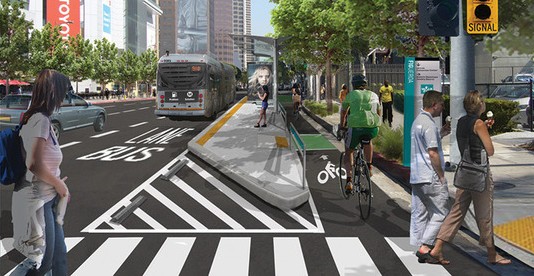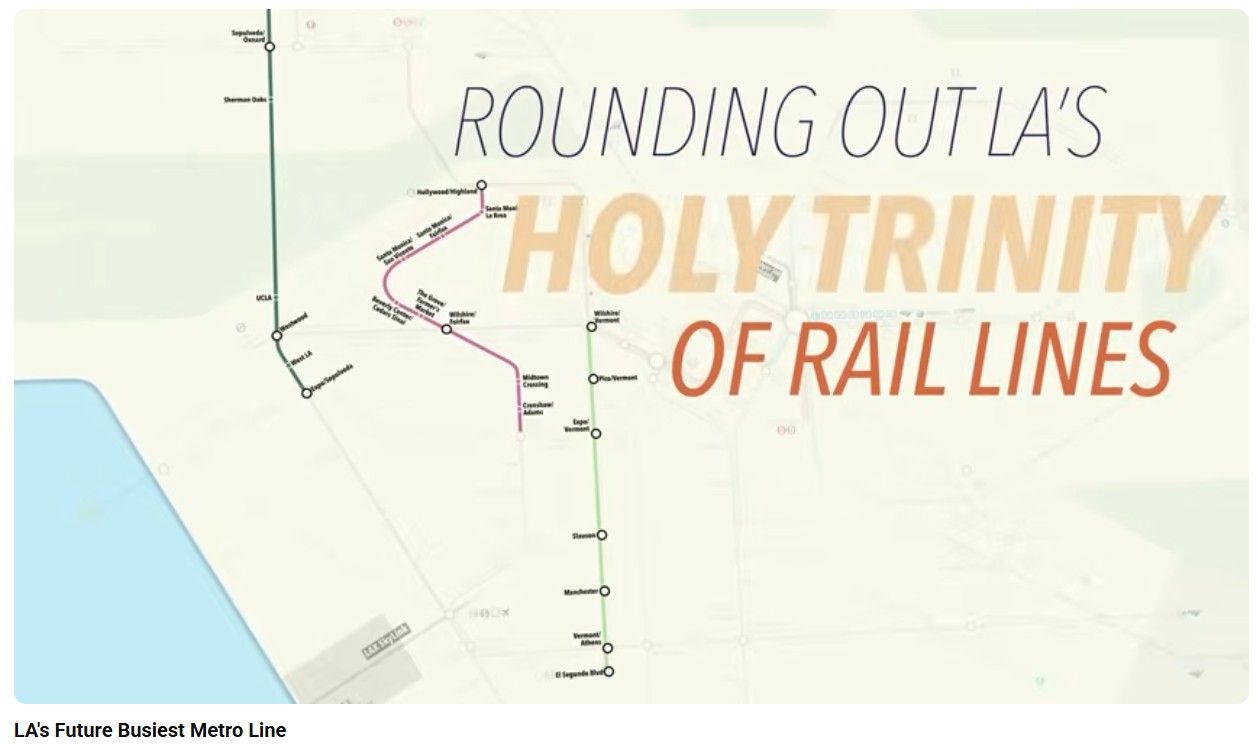Early last week, Michael MacDonald posted his helmet-camera video showing a Metro bus driver veering rightward into his path, then braking. The incident occurred on Adams Boulevard near Hauser. When MacDonald confronted the driver, he responds dismissively and closes the bus window.
The video bounced around the bike corner of cyberspace. It was picked up by Biking in L.A. who called it "a perfect test case for the city's cyclist anti-harassment ordinance." The footage ran on Univision and CBS.
There are other similar videos online. Below is one that took place on Santa Monica Boulevard, from YouTube user Wes + Bikes.
Though it doesn't get recorded on video often, I can personally confirm that this sort of merge conflict happens to lots of L.A. cyclists very frequently, especially those of us intrepid enough to "take the lane" on L.A.'s busier arterial bus-route streets. Yesterday, I bicycled from Koreatown to Downtown L.A. and had two transit vehicles merge into my path, one a Metro Bus and the other an LADOT DASH Shuttle. Public agency bus merges are frequent, as they get over to the curb to pick up passengers, but I've also been cut off by plenty of private vehicles, especially near freeway on-ramps, and driveways.
When a bus is passing me and I can read the situation to see that the driver is moving right to pick up passengers, here's what I do:
- I brake, slow way down, until I am behind the bus.
- I use hand gestures to tell the driver to keep merging rightward (sometimes it seems like the driver is expecting me to pass on the right, so they are braking, too, waiting for me.)
- Pass the bus on its left. Though buses can seem big and full of momentum and threatening to cyclists, the good news is that they don't have any doors on the left side, so, on the left, cyclists can pass fairly close to them with no threat of dooring.
- Throughout this negotiation, I try to remind myself that every 40-seat Metro bus I encounter is roughly 20-50 fewer cars on the road. I try to sympathize with that Metro driver who's doing her/his job navigating the same crappy traffic that I am.
I suspect this pass-left move will be more difficult for some of the very-fast-moving cyclists out there, but I think that slowing and passing on the left is generally the safest and least stressful way to go.
As Biking in L.A. reported, cyclists often report these incidents to via Metro's formal complaint process, then hear nothing back from the agency. MacDonald filed a complaint, and, to date, has yet to hear back. The agency quietly impenetrably seals customer complaints in the bus driver's personnel file.
In this case, though, Metro responded publicly. Well, sort of. While there was a tiny bit of media heat on this, Metro published this article on its The Source blog. Metro cited bus driver training materials - all the way from Chicago! The article concludes with Metro's 5 "key tips" advice to cyclists.
I've been thinking about key tips, bike safety, buses, and all. Here are a few key tips I have for Metro.
5 Key Tips for Metro Interaction with Bicyclists:
- Fund bike projects. Show us that the agency values cyclists lives. Sometimes it feels like Metro spends more effort putting bike photos on billboards than it does in putting bike facilities on the road. Metro's $88 billion 10-year Short Range Transportation Plan (SRTP) includes only $500 million for active transportation. That's 0.6 percent! Metro needs to up its game - perhaps get busy implementing the agency's first/last mile plan, and, in the long run, include robust bike facilities in all those big capital projects coming down the pipeline. Include these early, in the early stages of the planning process.
- Get bike share implemented. Metro has been studying and studying bike share, tentatively targeting rolling out a regional bike share system clustered in three initial spots: Santa Monica/Venice, Pasadena and Downtown Los Angeles. Some day they'll get around to putting out a Request for Proposals (RFP.) Convince us cyclists that you, Metro, aren't shy about commitment. Let's set a date! Just propose! Maybe sweeten that RFP by including plenty of bike share funding in that SRTP. Bike share, at $5-$17 million, is whole lot cheaper and healthier than those freeway projects you've been spending so much time with. Maybe even take bike share seriously enough to list it somewhere on Metro's Upcoming Projects page.
- Stop opposing bike projects. Bike lanes make for a great margin that makes bus/bike interactions at bus stops much easier. In my experience, that pass-on-the-left maneuver I described above is a lot easier where there's a bike lane. The bus merges to the right, into the bike lane, and, voilà! this great safe 5-foot-wide passing lane opens to the left of the bus. Just wide enough for bikes to pass, but not wide enough for cars. Metro staff testified against the North Figueroa bike lanes at last month's community meeting. Metro's official comment letter [pdf - page 12] decries the impacts of awesome bus stop features in MyFigueroa (see item 4 below), and requests extensive analysis of car traffic congestion before implementing L.A. city's year one priority bike lane projects.

Fund and build protected bike lanes. Protected bike lane projects, including MyFigueroa, include bulb-outs for bus boarding. These mingle cyclists and pedestrians, keeping them out of the way of buses. Watch this video - it's awesome.






